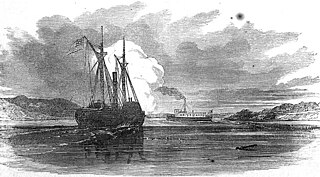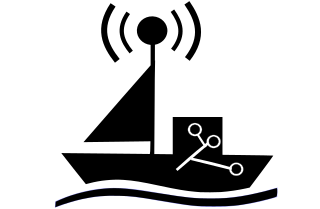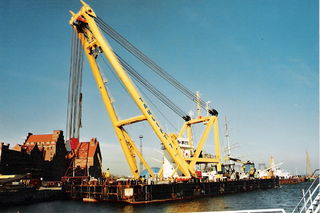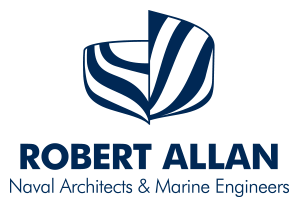
A tugboat or tug is a marine vessel that manoeuvres other vessels by pushing or pulling them, with direct contact or a tow line. These boats typically tug ships in circumstances where they cannot or should not move under their own power, such as in crowded harbors or narrow canals, or cannot move at all, such as barges, disabled ships, log rafts, or oil platforms. Some are ocean-going, and some are icebreakers or salvage tugs. Early models were powered by steam engines, which were later superseded by diesel engines. Many have deluge gun water jets, which help in firefighting, especially in harbours.

A survey vessel is any type of ship or boat that is used for underwater surveys, usually to collect data for mapping or planning underwater construction or mineral extraction. It is a type of research vessel, and may be designed for the purpose, modified for the purpose or temporarily put into the service as a vessel of opportunity, and may be crewed, remotely operated, or autonomous. The size and equipment vary to suit the task and availability.

An autonomous underwater vehicle (AUV) is a robot that travels underwater without requiring continuous input from an operator. AUVs constitute part of a larger group of undersea systems known as unmanned underwater vehicles, a classification that includes non-autonomous remotely operated underwater vehicles (ROVs) – controlled and powered from the surface by an operator/pilot via an umbilical or using remote control. In military applications an AUV is more often referred to as an unmanned undersea vehicle (UUV). Underwater gliders are a subclass of AUVs.

An unmanned ground vehicle (UGV) is a vehicle that operates while in contact with the ground and without an onboard human presence. UGVs can be used for many applications where it may be inconvenient, dangerous, or impossible to have a human operator present. Generally, the vehicle will have a set of sensors to observe the environment, and will either autonomously make decisions about its behavior or pass the information to a human operator at a different location who will control the vehicle through teleoperation.

A salvage tug, known also historically as a wrecking tug, is a specialized type of tugboat that is used to rescue ships that are in distress or in danger of sinking, or to salvage ships that have already sunk or run aground.

Unmanned underwater vehicles (UUV), sometimes known as underwater drones, are submersible vehicles that can operate underwater without a human occupant. These vehicles may be divided into two categories: remotely operated underwater vehicles (ROUVs) and autonomous underwater vehicles (AUVs). ROUVs are remotely controlled by a human operator. AUVs are automated and operate independently of direct human input.

A crane vessel, crane ship, crane barge, or floating crane is a ship with a crane specialized in lifting heavy loads, typically exceeding 1,500 t for modern ships. The largest crane vessels are used for offshore construction.

An unmanned surface vehicle, unmanned surface vessel or uncrewed surface vessel (USV), colloqually called a drone boat, drone ship or sea drone, is a boat or ship that operates on the surface of the water without a crew. USVs operate with various levels of autonomy, from remote control to fully autonomous surface vehicles (ASV).
DMS Maritime, formerly Defence Maritime Services, is a company providing port services to the Australian Defence Force and Marine Unit. It is a subsidiary of Serco.

A floating sheerleg is a floating water vessel with a crane built on shear legs. Unlike other types of crane vessel, it is not capable of rotating its crane independently of its hull.

Robert Allan Ltd. is Canada's oldest privately owned consulting Naval Architectural firm, established in Vancouver, British Columbia in 1930. Their experience includes designs for vessels of almost all types, from small fishing boats to ocean-going ferries. The firm is best known for its work in the fields of tug and barge transportation, ship-assist and escort tugs, fast patrol craft, fireboats and shallow-draft vessels. They provide professional marine consulting and design services to a worldwide client base.

Marine technology is defined by WEGEMT as "technologies for the safe use, exploitation, protection of, and intervention in, the marine environment." In this regard, according to WEGEMT, the technologies involved in marine technology are the following: naval architecture, marine engineering, ship design, ship building and ship operations; oil and gas exploration, exploitation, and production; hydrodynamics, navigation, sea surface and sub-surface support, underwater technology and engineering; marine resources ; transport logistics and economics; inland, coastal, short sea and deep sea shipping; protection of the marine environment; leisure and safety.

The Valiant class is a class of US Navy yard tugboats (YT) that entered service in 2009. These tugs are designed to provide ship assist, barge and general towing, and escort services.

RV Falkor is an oceanographic research vessel operated by the Schmidt Ocean Institute. Ship time aboard the vessel is made freely available to researchers once they have undergone an application, peer review process, and their proposal has been accepted. One condition for using the Falkor is that research findings and data from all expeditions are made publicly available. Researchers aboard Falkor receive expert shipboard support, use of scientific equipment, as well as robotic and computational resources. RV Falkor is adaptable and can facilitate new technologies and external resources as required for each science expedition. Falkor’s current status and a virtual ship tour are publicly available on the Schmidt Ocean Institute website. The Schmidt Ocean Institute announced the change of ownership of the vessel on 14. March 2022. It was renamed to Gaia Blu and is used by the italian National Research Council. It concluded its first science expedition at the 20. October 2022.

Autonomous cargo ships, also known as autonomous container ships or maritime autonomous surface ships (MASS), are crewless vessels that transport either containers or bulk cargo over navigable waters with little or no human interaction. Different methods and levels of autonomy can be achieved through monitoring and remote control from a nearby manned ship, an onshore control center or through artificial intelligence and machine learning, letting the vessel itself decide the course of action.

The e5 Project is a Japanese consortium with the purpose of developing renewably-powered commercial ships.

Built Robotics Inc. is a San Francisco, California, US-based vehicular automation startup that develops software and hardware to automate construction equipment. The company was founded in San Francisco in 2016 by Noah Ready-Campbell and Andrew Liang. The company’s primary product is the “Exosystem,” an aftermarket kit that adds autonomous robotic capabilities onto existing heavy equipment through a combination of GPS, camera, and artificial intelligence technology.
USV Maxlimer is a semi-autonomous, remotely controlled unmanned surface vehicle (USV) owned and operated by the British company SEA-KIT International. She was the winning entry in the Shell Ocean Discovery X Prize competition, and subsequently has been used as a proof-of-concept vessel for uncrewed, over-the-horizon offshore operations.
Echo Voyager is an autonomous underwater vehicle (AUV) built by Boeing.
Autonomous and Remote Navigation Trial Project is the trial of maritime autonomous surface ships (MASS) in commercial operations hold within 2020 in three different sea water areas of Russia.














